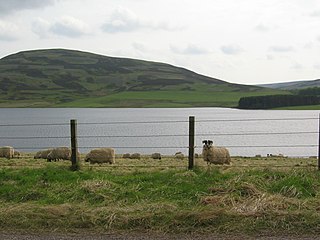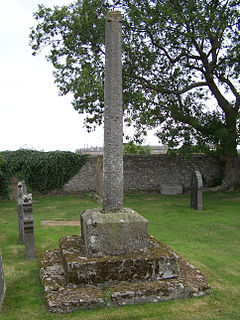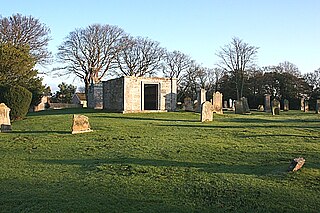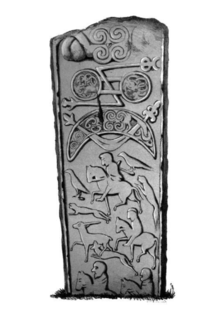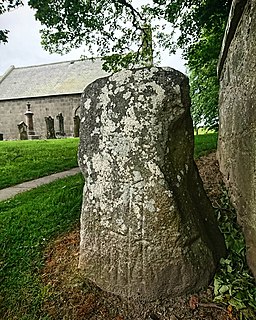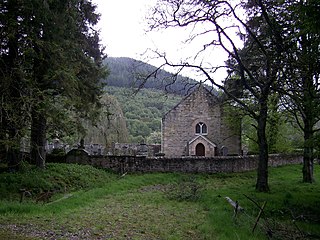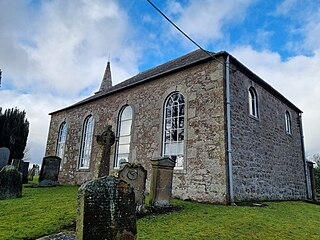The Drainie carved stones are a collection of 32 Pictish stones originating from the important early medieval monastic settlement of Kinneddar on the outskirts of the modern town of Lossiemouth in Moray, Scotland. Despite their name the majority were discovered at Kinneddar - the location of the manse of the parish of Drainie from which they take their name - rather than the separate settlement of Drainie which lay several miles to the west.
The 32 stone fragments probably represent the remains of ten cross-slabs, three free-standing crosses and at least eight panels from stone shrine chests. [1] Some of the sculpture is unfinished showing that it was produced on-site at Kinneddar. [2]
- Drainie 2, 3, 4, 5, 6, 7, 8, 9, 10 and 16
- Drainie 1, 11, 12, 13, and 17
| Type | Date | Dimensions | Location found | Date found | Current location | Notes | |
|---|---|---|---|---|---|---|---|
| Drainie 1 | Symbol stone | 7th century | H 0.75m x W 0.63m x D 0.10m | Drainie Manse, Kinneddar | 1855 | Lost | [3] |
| Drainie 2 | Cross-slab fragment | 8th or 9th century | H 0.28m x W 0.19m x D 0.08m | Kinneddar | In or before 1855 | Elgin Museum | [4] |
| Drainie 3 | Cross-slab fragments | 9th or 10th century | H 0.16m x W 0.30m x 0.06m | Kinneddar | In or before 1855 | Elgin Museum | Broken into two fragments, Drainie 3 formed part of the same cross slab as Drainie 8. [5] |
| Drainie 4 | Cross-slab fragment | 9th century | H 0.23m x W 0.19m x D 0.10m | Kinneddar | In or before 1855 | Elgin Museum | [6] |
| Drainie 5 | Carved fragment | 8th or 9th century | H 0.08m x W 0.16m | Kinneddar | In or before 1855 | Elgin Museum | Probably part of the same monument as Drainie 24, which was probably a shrine panel. [7] |
| Drainie 6 | Carved fragment | 8th century | H 0.16m x W 0.16m x D 0.09m | Kinneddar | In or before 1855 | Elgin Museum | Small fragment of a panel or cross-slab. [8] |
| Drainie 7 | Cross fragment | 8th or 9th century | H 0.10m x W 0.13m x D 0.05m | Kinneddar | In or before 1855 | Elgin Museum | May have formed part of a slender cross-shaft, that could have supported a cross-head such as Drainie 9. [9] |
| Drainie 8 | Cross-slab fragment | 9th or 10th century | H 0.25m x W 0.16m x W 0.08m | Kinneddar | In or before 1855 | Elgin Museum | Part of the same cross slab as Drainie 3. [10] |
| Drainie 9 | Cross fragment | 9th century | H 0.18m x W 0.15m x D 0.05m | Kinneddar | In or before 1855 | Elgin Museum | Probably part of the side arm of a ringed cross. [11] |
| Drainie 10 | Cross-shaft fragment | 9th century | H 0.28m x W 0.28m x D 0.13m | Kinneddar | In or before 1855 | Elgin Museum | Part of a slender tapered cross-shaft. [12] |
| Drainie 11 | Cross-slab fragment | 9th century | H 0.26m x W 0.48m x D 0.11m | Kinneddar | In or before 1855 | Elgin Museum | [13] |
| Drainie 12 | Cross-slab fragment | 8th or 9th century | H 0.38m x W 0.33m x D 0.33m | Kinneddar | In or before 1855 | Elgin Museum | [14] |
| Drainie 13 | Shrine panel fragment | 9th or 10th century | H 0.46m x W 0.34m x D 0.06m | Kinneddar | In or before 1855 | Elgin Museum | Carvings include images of parts of two galloping horses with five human figures beneath. [15] |
| Drainie 14 | Carved fragment | 8th or 9th century | H 0.45m x W 0.27m x D 0.04m | Kinneddar Old Kirkyard | 1884 | Elgin Museum, on loan from National Museums Scotland | Carvings include images of parts of two galloping horses with five human figures beneath. [16] |
| Drainie 15 | Cross-slab fragments | 9th or 10th century | H 0.31m x W 0.31m x D 0.06m | Kinneddar Old Kirkyard | 1900 | Elgin Museum | Two fragments of the top-left hand corner of a cross-slab. [17] |
| Drainie 16 | Carved fragment | 8th century | H 0.46m x W 0.46m x D 0.18m | Kinneddar | In or before 1855 | Elgin Museum | High relief carving ofh part of a scene showing David rending the jaws of a lion. [18] |
| Drainie 17 | Cross-slab fragment | 8th or 9th century | H 0.43m x W 0.61m x D 0.09m | Kinneddar | In or before 1855 | Elgin Museum | Possibly part of a cross-slab or possibly part of an altar frontal. [19] |
| Drainie 18 | Shrine panel fragments | 8th or 9th century | H 0.66m x W 0.93m x D 0.08m | Kinneddar Old Kirkyard | 1939 | Elgin Museum | Four adjacent fragments of a shrine panel. [20] |
| Drainie 19 | Unfinished cross-slab fragment | 8th or 9th century | H 0.45m x W 0.25m x D 0.06m | Kinneddar Old Kirkyard | 1960 | Elgin Museum | Fragment of a highly irregular cross-slab carving, suggesting that it is part of an unfinished monument. [21] |
| Drainie 20 | Carved fragment | 8th or 9th century | H 0.18m x W 0.11m x D 0.02m | In or near Kinneddar Old Kirkyard | After 1936 | Elgin Museum | Very thin fragment - more likely to be part of a panel than a cross-slab. [22] |
| Drainie 21 | Carved fragment | 8th or 9th century | H 0.16m x W 0.22m x D 0.05m | In or near Kinneddar Old Kirkyard | After 1936 | Elgin Museum | Very thin fragment - more likely to be part of a panel than a cross-slab. [23] |
| Drainie 22 | Cross-shaft fragment | 8th or 9th century | H 0.23m x W 0.16m x D 0.09m | In or near Kinneddar Old Kirkyard | After 1936 | Elgin Museum | Part of a slender cross-shaft. [24] |
| Drainie 23 | Shrine panel fragment | 8th century | H 0.22m x W 0.25m x D 0.06m | In or near Kinneddar Old Kirkyard | After 1936 | Elgin Museum | Possibly part of the same monument as Drainie 26. [25] |
| Drainie 24 | Shrine panel fragment | 8th or 9th century | H 0.30m x W 0.27m x D 0.09m | Kinneddar Old Kirkyard | 1978 | Elgin Museum | Probably part of the same monument as Drainie 5, which was probably a shrine panel. [26] |
| Drainie 25 | Cross-slab fragment | 8th or 9th century | H 0.15m x W 0.19m x D 0.09m | Kinneddar Old Kirkyard | After 1936 | Elgin Museum | Forms part of the side of a cross-slab with Drainie 27. [27] |
| Drainie 26 | Shrine panel fragment | 8th century | H 0.15m x W 0.24m x D 0.09m | In or near Kinneddar Old Kirkyard | After 1936 | Elgin Museum | Forms part of the top right-hand side of a shrine panel alongside Drainie 28. Possibly part of the same monument at Drainie 23. [28] |
| Drainie 27 | Cross-slab fragment | 8th or 9th century | H 0.26m x W 0.20m x D 0.09m | In or near Kinneddar Old Kirkyard | After 1936 | Elgin Museum | Forms part of the side of a cross-slab with Drainie 25. [29] |
| Drainie 28 | Shrine panel fragment | 8th century | H 0.08m x W 0.08m x D 0.09m | In or near Kinneddar Old Kirkyard | After 1936 | Elgin Museum | Forms part of the top right-hand side of a shrine panel alongside Drainie 26. Possibly part of the same monument at Drainie 23. [30] |
| Drainie 29 | Shrine panel fragment | 8th century | H 0.19m x W 0.18m x D 0.08m | In or near Kinneddar Old Kirkyard | After 1936 | Elgin Museum | Part of the top of a hybrid post-and-panel, or the end-panel of a shrine. [31] |
| Drainie 30 | Carved fragment | 8th or 9th century | H 0.12m x W 0.14m x D 0.07m | In or near Kinneddar Old Kirkyard | After 1936 | Elgin Museum | Small fragment, possibly part of a cross-slab. [32] |
| Drainie 31 | Carved fragment | Uncertain | H 0.18m x W 0.18m | In or near Kinneddar Old Kirkyard | After 1936 | Elgin Museum | Severely damaged carved fragment. [33] |
| Drainie 32 | Cross-slab fragment | Uncertain | H 0.46m x W 0.38m x D 0.08m | Gordonstoun School | c. 1965 | Elgin Museum | Discovered at Gordonstoun School in a dump of stones removed from the Old Kirk at Drainie when it was demolished for the extension of the runway of RAF Lossiemouth in 1953. Probably originated at Kinneddar as stone from Kinneddar was used in the construction of Drainie Kirk in the 17th century. [34] |










